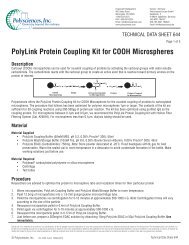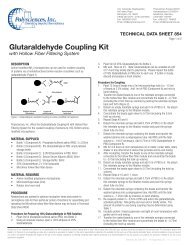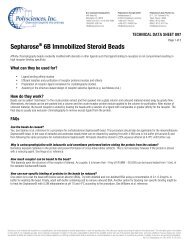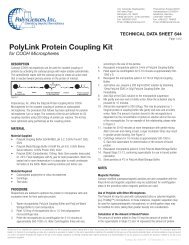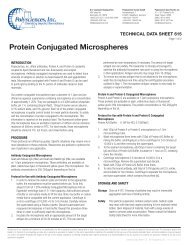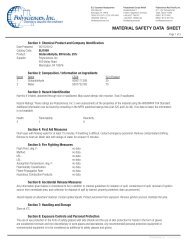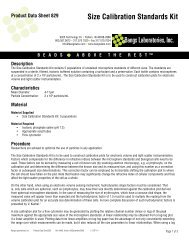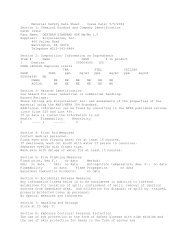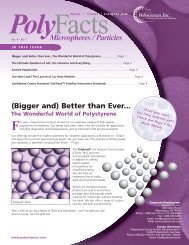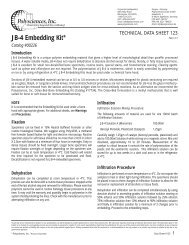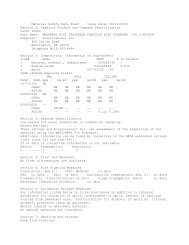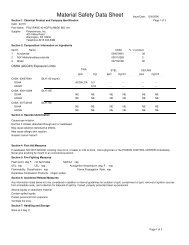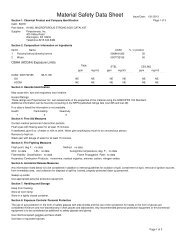3025 MICROSCOPE SERIES INSTRUCTIONS - Polysciences, Inc.
3025 MICROSCOPE SERIES INSTRUCTIONS - Polysciences, Inc.
3025 MICROSCOPE SERIES INSTRUCTIONS - Polysciences, Inc.
Create successful ePaper yourself
Turn your PDF publications into a flip-book with our unique Google optimized e-Paper software.
<strong>3025</strong> <strong>MICROSCOPE</strong> <strong>SERIES</strong><br />
<strong>INSTRUCTIONS</strong><br />
<strong>Polysciences</strong>, <strong>Inc</strong>.<br />
400 Valley Road<br />
Warrington, PA 18976<br />
(800) 523-2575 / (215) 343-6484<br />
(800) 343-3291 / (215) 343-0214 fax<br />
info@polysciences.com<br />
www.polysciences.com<br />
<strong>Polysciences</strong> Europe GmbH<br />
Handelsstrasse 3<br />
D-69214 Eppelheim<br />
Germany<br />
(49) 6221-765767<br />
(49) 6221-764620 fax<br />
info@polysciences.de<br />
Asia-Pacific Headquarters<br />
<strong>Polysciences</strong> Asia Pacific, <strong>Inc</strong>.<br />
2F-1, 207 Tunhwa N. Rd.<br />
Taipei, Taiwan 10595<br />
(886) 2 8712 0600<br />
(886) 2 8712 2677 fax<br />
info@polysciences.tw<br />
Our catalog lists over 3,000 unique and specialty products that are used by histology professionals, lab technicians,<br />
pathologists, chemists and scientists worldwide. Visit www.polysciences.com to learn more about our product lines.
TABLE OF CONTENTS<br />
Safety notes……………………………………………………………… i<br />
Care and Maintenance…………………………………………………. ii<br />
1. Components Illustration………………………….…………..………… 1<br />
2. Installation of Components…………………………….………………. 4<br />
2.1 Installation Diagram………………………………………………………...… 4<br />
2.2 Installation Procedures…………………………………………………………5<br />
3. Operation………………………………………………….……………..11<br />
4. Technical Specifications……………………………...….…………….. 15<br />
5. Trouble Shooting Guide.......................................................................... 16
SAFETY NOTES<br />
1. Open the shipping carton carefully to prevent any accessory, i.e. objectives or eyepieces, from<br />
dropping and being damaged.<br />
2. Do not discard the molded Styrofoam container; the container should be retained should the<br />
microscope ever require reshipment.<br />
3. Keep the instrument out of direct sunlight, high temperature or humidity, and dusty environments.<br />
Ensure the microscope is located on a smooth, level and firm surface.<br />
4. If any specimen solutions or other liquids splash onto the stage, objective or any other component,<br />
disconnect the power cord immediately and wipe up the spillage. Otherwise, the instrument may<br />
be damaged.<br />
5. CAUTION: the lamp, lamp housing and adjacent parts will become very hot. Do not touch these<br />
parts until they have completely cooled. Never attempt to handle a hot halogen bulb.<br />
6. All electrical connectors (power cord) should be inserted into an electrical surge suppressor to<br />
prevent damage due to voltage fluctuations.<br />
7. For safety when replacing the halogen lamp or fuse, be sure the main switch is off (“O”), remove<br />
the power cord, and replace the halogen bulb after the bulb and the lamp house has completely<br />
cooled.<br />
8. Confirm that the input voltage indicated on your microscope corresponds to your line voltage. The<br />
use of a different input voltage than indicated will cause severe damage to the microscope.<br />
i
COMPONENTS ILLUSTRATION<br />
1
6<br />
Video Port (optional)<br />
5<br />
10×Wide Field Eyepiece<br />
2<br />
Trinocular Viewing Head<br />
4<br />
Infinity Plan Objectives<br />
1<br />
Microscope Body<br />
3<br />
Mechanical Stage Mounting Assembly<br />
Lamp House<br />
3
2-2 Assembly <strong>3025</strong><br />
Guide Board<br />
Figure 1<br />
Locking Block and Bolt<br />
Figure 2<br />
Figure 3<br />
4<br />
4
2-2-1 Installing the Mechanical Stage Mounting Assembly<br />
1. Before installing the mechanical stage mounting device, be sure to adjust the coarse focus<br />
knob until the guide board (Figure 1) is at its lowest position. This allows you to install<br />
the mechanical stage easily. Use the 3.0mm hexagonal Allen wrench to connect the<br />
mechanical stage mounting support assembly and the guide board. Ensure the connection<br />
is tight and secure.<br />
2. Place the mechanical stage mechanical assembly (Figure 2) onto the top of the guide<br />
board (Figure 1). Ensure the assembly (Figure 2) is completely attached to the guide board before<br />
tightening the allen screw.<br />
The mechanical stage has been factory assembled and adjusted. Disassembly of the<br />
mechanical stage should be attempted only by a trained microscope service<br />
technician.<br />
5
<strong>3025</strong><br />
2-2-2 Installing the Trinocular Viewing Head<br />
Insert the trinocular viewing head (Fig.4) into the<br />
microscope body (Fig. 5); then rotate the head into<br />
Figure 4<br />
its proper viewing position. Use the 2.5mm<br />
hexagonal wrench to attach the viewing head to the<br />
body by tightening the allen screw. Ensure the head<br />
Bolt<br />
is securely attached.<br />
Figure 5<br />
2-2-3 Installing and Replacing the Lamp<br />
(Figure 6)<br />
Halogen Lamp: 6 Volt 30 Watt: Do not use a<br />
lamp of a different voltage or wattage.<br />
1.Turn the power switch to the off position and remove<br />
the power cord.<br />
Bolt<br />
Lamp House Bolt<br />
Figure 6<br />
2. Allow the lamp house and bulb to completely cool.<br />
Remove the lamp housing by pulling gently.<br />
Remove the old lamp from the socket and replace<br />
with a 6V30W halogen lamp.<br />
Do not touch the halogen lamp with your bare<br />
fingers. Doing so will shorten the service life of the<br />
lamp. Use a soft, clean cloth or lint free paper tissue.<br />
6<br />
6
<strong>3025</strong><br />
2-2-4 Installing the Lamp House<br />
Align the lamp house bolt (Fig. 6)<br />
with the jack on the back of the<br />
microscope (Fig.7), then gently push the<br />
lamp holder into the housing until they<br />
are completely against each other<br />
(Fig. 8).<br />
Jack<br />
Figure 7<br />
2-2-5 Installing the Objectives<br />
1. Rotate the coarse focus knob until the<br />
mechanical stage is at its lowest position.<br />
2. Install the lowest magnification objective into the<br />
Figure 8<br />
nosepiece (Fig. 9). Then in a clock-wise<br />
direction rotate the nosepiece and install the<br />
objectives in succeeding higher magnification<br />
sequence (Fig. 10).<br />
Inspect the objectives regularly for dust, dirt<br />
and oil. Clean the objectives according to the<br />
directions in the “Care and Maintenance”<br />
Figure 9<br />
section.<br />
Use the 10x objective to initially focus the<br />
image of your specimen.<br />
To change objectives, rotate the nosepiece<br />
until you hear a “click” sound. This ensures<br />
the objective is centered in the optical light<br />
path.<br />
Figure 10<br />
7
<strong>3025</strong><br />
Eyepiece<br />
2-2-6 Installing the Eyepieces<br />
Fig. 11<br />
Fig. 12<br />
Remove the protective caps from the<br />
eyepiece tubes. Insert the eyepieces into the<br />
eyepiece tubes (Fig. 11).<br />
Thumb<br />
Screw<br />
2-2-7Installing the Video Port (optional)<br />
Figure 13<br />
Remove the protective cap from the<br />
vertical tube of the viewing head. Insert<br />
the video port (Fig. 12) into the trinocular<br />
viewing head (Fig. 13), then tighten the<br />
thumb screw.<br />
Figure 14<br />
8<br />
8
Condenser Adjustment<br />
Knob<br />
Upper Stage<br />
Limit Control<br />
Fine Focus<br />
Knob<br />
Field Diaphragm<br />
Coarse Focus<br />
Knob<br />
9
Interpupillary Distance<br />
Indicator<br />
Swing Out Condenser<br />
with Iris Diaphragm<br />
Tension Control<br />
Collar<br />
Variable Light<br />
Intensity<br />
Adjustment Dial<br />
Y Stage Movement<br />
Adjustment Knob<br />
X Stage Movement<br />
Adjustment Knob<br />
10
<strong>3025</strong><br />
4-1 Turning on the Lamp (Figure 15)<br />
Connect the power cord, turn on the main switch (Figure<br />
15) to the on position “--”<br />
Main switch<br />
NOTE: The switch adjacent to the main switch is<br />
non-functioning.<br />
Figure 15<br />
4-2 Adjusting Illumination Intensity (Figure 16)<br />
Adjust the illumination intensity by rotating the variable<br />
intensity dial.<br />
Use of the lamp at a lower intensity will prolong its<br />
life.<br />
Figure 16<br />
4-3Adjusting Tension Adjustment Collar<br />
(Figure 17)<br />
The tightness of the tension adjustment collar is<br />
factory adjusted. If the collar loosens or the<br />
mechanical stage drops by itself, adjust the tension<br />
adjustment collar until the proper tension is restored.<br />
Tension Adjustment Collar<br />
Figure 17<br />
Use the black adjusting wrench supplied with the<br />
microscope to adjust the tension adjustment collar<br />
11<br />
11
<strong>3025</strong><br />
4-4 Placement of Specimen (Fig. 18)<br />
Place the slide on the mechanical stage. Use the slide<br />
holder to gently secure the slide. Turn the X and/or Y<br />
stage movement adjustment knobs to position the<br />
specimen.<br />
Use caution when changing objectives. Do not<br />
allow an objective to touch a specimen slide. Doing so<br />
Figure 18<br />
may damage the objective and specimen.<br />
4-5 Adjusting the Interpupillary Distance<br />
(Figure 19)<br />
The interpupillary distance range: 48mm~75mm.<br />
While observing with two eyes, hold the left and right<br />
eyetubes. Rotate the eyetubes around the central axis.<br />
Adjust the interpupillary distance until the left and right<br />
fields of view coincide completely with one image.<br />
Figure 19<br />
4-6 Adjusting the Diopter (Figure 20)<br />
1. Using the 10x objective and your right eye<br />
only, observe your specimen through the right<br />
eyepiece only and bring it into focus.<br />
Diopter Collar<br />
2. Then observe the specimen with your left eye<br />
only through the left eyepiece. If the specimen<br />
is not in focus, rotate the diopter collar (Fig.20)<br />
until a sharp image is obtained.<br />
The diopter range is ±5<br />
Figure 20<br />
12<br />
12
<strong>3025</strong><br />
4-7 Focusing (Figures 21 & 22)<br />
Figure 21<br />
Push the light path selector lever (Figure 25) completely in.<br />
Lower the mechanical stage. With the 10x objective in<br />
position, raise the mechanical stage slowly using the coarse<br />
focusing knob until the specimen is in focus. Then rotate<br />
the fine focus until a sharp image is obtained. Do not allow<br />
the objective to touch the specimen.<br />
Figure 22<br />
4-8 Adjusting the Swing Out Condenser<br />
(Figure 23)<br />
The center of the condenser and the light axis of the<br />
objective are coaxial. They have been factory adjusted<br />
and does not need to be adjusted . The upper limit of<br />
the condenser has also been adjusted.<br />
Turn the condenser focus knob to adjust the<br />
condenser. Raise the condenser when using the<br />
higher magnification objectives, and lower the<br />
condenser when using lower magnification<br />
objectives.<br />
Swing Out Condenser<br />
Aperture Diaphragm<br />
Swing out the condenser and away from the<br />
light path when using the 4x objective. Swing<br />
in the condenser and into the light path when<br />
using the 10x and higher magnification<br />
objectives.<br />
Figure 23<br />
Adjusting the Aperture Diaphragm<br />
The aperture diaphragm is designed for the adjustment of the numerical aperture, not for brightness.<br />
Generally, reducing the diaphragm opening to 70-80% of the N.A. value of the respective objective<br />
will provide an image of acceptable quality. If you want to observe the image of the aperture<br />
diaphragm, remove one eyepiece and look through the tube. You will see a dark circle encroaching on<br />
the bottom of the tube<br />
13
Specifications <strong>3025</strong><br />
Main specifications<br />
Optical System Infinity Optical System<br />
Viewing Head<br />
Compensation Free Trinocular Head, <strong>Inc</strong>lined 30º; Diopter ±5<br />
Interpupillary distance: 48-75mm<br />
Eyepiece (Ocular) Extra Wide Field EW10X/22, tube30 matched<br />
Nosepiece<br />
Reversed Quintuple Nosepiece<br />
Objectives<br />
Infinity Plan Achromat: 4x, 10x, 40x, 100x Oil<br />
Focus System<br />
Coaxial Coarse and Fine Focusing System<br />
Sensitivity and Graduation of Fine Focus: 0.001mm<br />
Stage Double plate mechanical stage; 185 x 142mm; movement range: 75 x 55mm<br />
Koehler Illumination Koehler illumination system, Aspheric collector, halogen lamp 6V30W<br />
Condenser Swing out condenser N.A. 0.9<br />
Configuration Table<br />
Viewing Head Compensation Free Trinocular Head <br />
Eyepiece Extra Wide Field Eyepieces: EW10x/22 <br />
Objectives<br />
Infinite Plan objectives: 4x, 10x, 40x, 100x Oil<br />
<br />
Infinite Plan Objective: 20x<br />
<br />
Condenser Swing out Condenser N.A. 0.9/0.25 <br />
Video Accessories<br />
<br />
Video Mount<br />
C-Mount 1x<br />
<br />
C-Mount 0.5x<br />
<br />
Polarization<br />
○<br />
Turret Phase Contrast<br />
Condenser<br />
○<br />
Darkfield Condenser<br />
○<br />
Fluorescent<br />
Attachment<br />
○<br />
Temperature Control<br />
Device<br />
○<br />
Note: ●Standard ○ Optional<br />
Objective Specifications<br />
Magnification<br />
Numerical Value<br />
Working Thickness of Conjugate<br />
Aperture<br />
Objective Color<br />
Distance Cover Slip Distance<br />
Diaphragm<br />
Coding<br />
(mm) (mm) (mm)<br />
(N.A.)<br />
4X 0.10 25.42 0.17 Red<br />
10X 0.25 11 0.17 Yellow<br />
40X 0.65 0.75 0.17 Blue<br />
100X 1.25 0.21 0.17 Black and White<br />
15<br />
15
IMAGE PROBLEMS<br />
Problem Cause Corrective Measure<br />
Image tinged yellow Lamp intensity is too low Adjust the light intensity by<br />
rotating the intensity control<br />
dial<br />
Image is too bright Lamp intensity is too high Adjust the light intensity by<br />
rotating the intensity control<br />
dial<br />
Insufficient brightness Lamp intensity is too low Adjust the light intensity by<br />
rotating the intensity control<br />
dial<br />
Aperture diaphragm closed<br />
too far<br />
Condenser position too low<br />
Open to the proper setting<br />
Position the condenser at<br />
the upper limit<br />
MECHANICAL PROBLEMS<br />
Image will not focus with Slide upside down Turn the slide over so the<br />
high power objectives<br />
cover glass faces up<br />
Cover glass is to thick<br />
Use a 0.17mm cover glass<br />
High power objective contacts Slide upside down Turn the slide over so the<br />
slide when changed from<br />
cover glass faces up<br />
low power objective<br />
Cover glass is to thick<br />
Use a 0.17mm cover glass<br />
Diopter adjustment is not set<br />
properly<br />
Readjust the diopter settings<br />
Lamp does not light when No electrical power Check power cord connection<br />
switched on<br />
Lamp bulb burnt out<br />
Replace bulb<br />
Fuse blown out<br />
Replace fuse<br />
Slippage of focus when using Tension adjustment is set too <strong>Inc</strong>rease the tension on the<br />
the coarse focusing knob low focusing knobs<br />
Fine focus is ineffective Tension adjustment is set too Loosen the tension on the<br />
high<br />
focusing knobs<br />
17
ORDERING INFORMATION<br />
Cat. #<br />
25097<br />
Description<br />
<strong>3025</strong> Upright Microscope with Dual Observation 1 unit<br />
Order online anytime at www.polysciences.com<br />
<strong>Polysciences</strong>, <strong>Inc</strong>.<br />
<strong>Polysciences</strong> Europe GmbH<br />
Asia-Pacific Headquarters<br />
400 Valley Road<br />
Warrington, PA 18976<br />
(800) 523-2575 / (215) 343-6484<br />
(800) 343-3291 / (215) 343-0214 fax<br />
info@polysciences.com<br />
www.polysciences.com<br />
Handelsstrasse 3<br />
D-69214 Eppelheim<br />
Germany<br />
(49) 6221-765767<br />
(49) 6221-764620 fax<br />
info@polysciences.de<br />
<strong>Polysciences</strong> Asia Pacific, <strong>Inc</strong>.<br />
2F-1, 207 Tunhwa N. Rd.<br />
Taipei, Taiwan 10595<br />
(886) 2 8712 0600<br />
(886) 2 8712 2677 fax<br />
info@polysciences.tw<br />
Our catalog lists over 3,000 unique and specialty products that are used by histology professionals, lab technicians,<br />
pathologists, chemists and scientists worldwide. Visit www.polysciences.com to learn more about our product lines.



